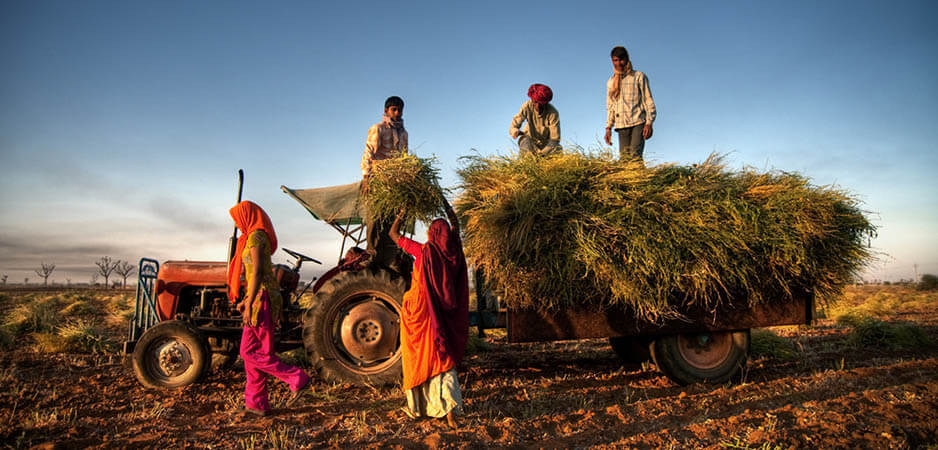Broken credit markets and the primacy of special interests are putting enormous burdens on Indian taxpayers and farmers.
Countries across the world subsidize agriculture. A key reason for this has been food security. Other reasons such as equity, environmental and cultural concerns also inform the decision to do so. In France, the countryside has long held a powerful draw on the popular imagination, at least since the days of Jean Jacques Rousseau. Therefore, it has pioneered the common agricultural policy in Europe. Even the capitalist United States is generous with its farm subsidies.
India has always subsidized agriculture for two reasons. First, it had bitter experiences of repeated famines under British rule, making food security a fundamental priority. Second, most Indians have always relied on farming to make ends meet. Until last year, agriculture provided 49% of employment in the country. This large percentage of the population often works on small farms and survives hand to mouth, making equity an overriding policy concern in an increasingly unequal fast-growing economy. Given India’s history of social stratification and economic marginalization, this concern assumes added importance.
THE STORY OF CREDIT IN INDIA
The story of credit in rural India is complex. The British sucked rural areas dry through a combination of excessive taxation and exploitative trade practices. India became the land where they grew opium, which they exported to China. This meant famine for Indians because they could no longer grow rice or wheat. By the time the British left, there was no credit in rural India. The only people who could provide some credit were the much maligned moneylenders.
The moneylenders are still called sahukars and are often the only sources of credit in the countryside. Even though they give loans at an exorbitant rate, farmers have no other places to turn to in times of distress. The practice of all children inheriting the family farm has led to acute fragmentation. Small plots of land are often not viable even for subsistence farming. Add to it the fact that 52% of agricultural land in India is “still un-irrigated and rainfed.” This means farmers are one bad monsoon away from unmitigated disaster.
It was partly to solve this problem that the government started nationalizing banks. While the process began in 1955, the big wave of bank nationalization occurred in 1969. The chief rationalization for this measure was to extend equity to farmers in India’s underserved rural areas. Indira Gandhi, who was prime minister at the time, justified nationalization on the grounds of improving economic development, reducing regional disparities, removing poverty and increasing employment.
Sadly for the late prime minister, this vision has not exactly materialized. India’s infamous bureaucracy and Kafkaesque red tape ensures that only the relatively prosperous and socially connected farmers manage to get loans. This means that loans do not go to the neediest.
In India’s rambunctious democracy, an additional feature soon emerged. Politicians could force state-owned banks to make decisions that were politically expedient, even if economically harmful. So, farmers started asking for waivers of farm loans and politicians started competing with each other to forgive them.
WHY FARM LOANS FAIL
The politics of farm loan waivers raises a key question: Why do these loans fail?
First, the repeated cycles of loan waivers has ensured the dual economic problem of moral hazard and adverse selection. Simply put, many farmers take loans with no intention of repaying them. Furthermore, the bank has less information than the farmers about their ability and, more importantly, willingness to repay loans. Institutional decline has further corroded the banks’ ability to make the correct lending decisions.
Second, agriculture in India continues to be volatile. The Economy Survey 2018 published by the government chronicles the reduction of volatility over time. From 1960 to 2004, the standard deviation of agricultural production was 6.3%. From 2004 to 2018, this figure came down to 2.9%. This is a significant achievement, but it still leaves much risk for farmers. In the 52% rainfed areas, this risk is naturally higher. Drought or flood can easily lead to loan defaults.
Third, the Agricultural Produce Market Committee (APMC) has set a ceiling on the price farmers can get for their produce. As per the Indian government, about 2,477 principal markets and 4,843 submarkets are run by APMCs. The concept of APMC emerged to protect farmers from intermediaries such as money lenders. Farmers have to bring their produce to markets run by APMCs to be sold through auction. In theory, this should have worked splendidly. In reality, local politicians and special interests control APMCs.
A measure to protect farmers now ensures their exploitation. Since APMCs are the only buyers, this leads to the economic problem of monopsony. APMCs hold farmers over a barrel and break their backs by offering them precipitously low prices. In a recent incident, a farmer received just over 1 rupee (1 cent) per kilogram for the onions he sold to an APMC-controlled market.
Not only do farmers receive low prices, they rarely get their payment promptly. The delay is weeks, if not months. Also, traders often arbitrarily force a haircut on beleaguered farmers, speciously claiming a cash crunch. There is another fly in the ointment. Buyers from APMCs do not give receipts to farmers. This means farmers cannot prove their income to banks that require extensive paperwork to determine eligibility. As they cannot prove their income level, they do not get loans, leaving them prey to exorbitant rates by sahukars when they need credit.
Fourth, while APMCs impose a ceiling on the prices that farmers receive, the National Rural Employment Guarantee Act (NREGA) imposes a floor for wages they have to pay. India’s NREGA programs provide at least 100 days of guaranteed wage employment to every family. While this measure was motivated by welfare concerns, one of its side effects was increasing the cost of labor for farmers, squeezing them even harder.
Fifth, farmers have no recourse to storage and have to sell their produce immediately after harvest. This lack of storage exacerbates their vulnerability. They have to sell before their crops rot, tilting the balance of power even further in favor of traders. Often, this harms consumers too because traders indulge in profiteering by hoarding and creating artificial scarcities. In 2015, this contributed to high prices for pulses.
OF PROMISES AND PERILS
Like many other countries, the overriding incentive of Indian politicians is to win elections. They can only do so by solving the most immediate issues facing their voters. Farmers unable or unwilling to pay back bank loans know that politicians will be most amenable to write them off in return for political support. Therefore, farmers clamor for loan write-offs during each election with much success. Ironically, only a few relatively well-off farmers get debt relief, giving the vast majority no benefit at all. To add insult to injury, some prosperous farmers game the system repeatedly, ruthlessly ripping off the taxpayer.
Such is the scale of the write-offs that they are nearing $12 billion, increasing by 38.2% in the fiscal year 2017-18 alone. Last year, two of the authors explained India’s financial crisis in much detail. Indian banks are saddled with non-performing assets (NPAs). With an NPA ratio of 9.85%, India had the fifth highest NPA ratio in the world, ranking only after Greece, Italy, Portugal and Ireland. Writing-off farmer loans is making the NPA problem worse and adding greater burdens to the taxpayer.
It is not only taxpayers but also small farmers whose burdens are increasing. Squeezed by volatility, APMCs and NREGA, they face rising costs and falling incomes. In a recent article, P. Sainath, the most eminent chronicler of rural India, points out how farmers face a terrifying crisis and far too many are unable to eke out a living. Even though India’s population is still rising, the number of farmers is falling by 2,040 every 24 hours. Farmers increasingly end up in debt traps and turn so desperate that they often take their lives.
Decades after independence, farmer suicides continue to be a major problem in India and are a testimony to the broken rural credit markets that need urgent reform. The operative question today is simple: Can India move beyond salves for symptoms in election season and address its increasingly acute rural debt disease?
The views expressed in this article are the author’s own and do not necessarily reflect Fair Observer’s editorial policy.
Support Fair Observer
We rely on your support for our independence, diversity and quality.
For more than 10 years, Fair Observer has been free, fair and independent. No billionaire owns us, no advertisers control us. We are a reader-supported nonprofit. Unlike many other publications, we keep our content free for readers regardless of where they live or whether they can afford to pay. We have no paywalls and no ads.
In the post-truth era of fake news, echo chambers and filter bubbles, we publish a plurality of perspectives from around the world. Anyone can publish with us, but everyone goes through a rigorous editorial process. So, you get fact-checked, well-reasoned content instead of noise.
We publish 2,500+ voices from 90+ countries. We also conduct education and training programs
on subjects ranging from digital media and journalism to writing and critical thinking. This
doesn’t come cheap. Servers, editors, trainers and web developers cost
money.
Please consider supporting us on a regular basis as a recurring donor or a
sustaining member.
Will you support FO’s journalism?
We rely on your support for our independence, diversity and quality.






